A Staple of the annual Ag Aviation Expo is the Aerial Application Technology Session, orchestrated by the USDA-ARS Aerial Application Technology Research Unit based in College Station, TX. Bringing together experts across the country, timely topics related to technology development, testing and field research are presented to keep aerial applicators abreast of the bleeding edge of application technology.
Presented December 4, 2023 at the NAAA Ag Aviation Expo in Palm Springs, CA.
- Impact of Nozzle Wear and Alignment on Spray Performance
- Enhancing Aerial Application Efficiency: The Advantages of Pulse Width Modulation
- The Effect of Adjuvants and Spray Nozzles on Droplets Size
- Creating composite images and vegetation index maps from Sentinel-2 satellite imagery using QGIS software
- Evaluation of drone, airplane and ground sprayers in simulated corn fungicide application
- Rain Enhancement with Commercial Agricultural Aircraft
- Value of the Agricultural Aerial Application Industry in the United States Delineated by Crops Grown and by State: A Counterfactual Study
Author: Brad Fritz, PhD
Abstract: Spray nozzles play an essential role in precision application of crop protection and production products, with advancements focusing on optimizing nozzle design, orifice size, and spray pressure to achieve desired spray patterns and droplet sizes. These factors directly impact the efficacy of the applied products. Over time and with continuous use, nozzles undergo wear, leading to alterations in their shape, structure, and internal geometry, potentially affecting spray performance and precision. Additionally, even slight misalignments of the nozzle on the boom can significantly change the quality of the spray being applied. We will look at wind tunnel testing results for both new and worn nozzles and the relative changes in flowrate, spray geometry, and droplet size due to wear. We will also examine how changes in the alignment of the nozzle relative to the direction of flight can alter spray quality. The results will provide insights into the potential consequences of nozzle wear and positional alignment on precision spray applications and highlight the importance of proper nozzle maintenance and inspection. The results will provide motivation to perform simple checks of your spray system in order to ensure consistent and effective spray applications, ultimately improving crop protection and production outcomes.
Bio: Dr. Brad Fritz is an agricultural engineer and serves as the Research Leader of the USDA ARS Aerial Application Technology Unit in College Station, Texas. His areas of research include spray drift measurement and methods of mitigation, understanding the role spray nozzles and formulations play in the droplet size being applied and optimizing aerial application technologies and methods to enhance on target deposition and reduce off-target impacts. He is an active member of a number of professional organizations including the American Society of Agricultural and Biological Engineers, the American Society of Testing and Materials, the American Mosquito Control Association, and the National Agricultural Aviation Association.
Author: Adam Madison
Abstract: Pulse Width Modulation (PWM) technology in aerial spray operations enables precise control of spray droplet size, rate, and distribution, enhancing efficiency and effectiveness. It allows for targeted distribution of agrochemicals, improving coverage, mitigating drift, and reducing environmental impact. PWM systems enable optimized spray patterns and offer flexibility and adaptability, allowing operators to adjust spray parameters based on crop requirements and environmental conditions, ensuring uniform crop coverage.
Bio: Adam Madison is a Field Technical Specialist with 10 years of experience at Capstan Ag Systems, specializing in the SwathPRO spray system. His extensive knowledge and technical expertise have played a crucial role in implementing and optimizing the SwathPRO system for pilots, ensuring efficient and precise spraying operations.
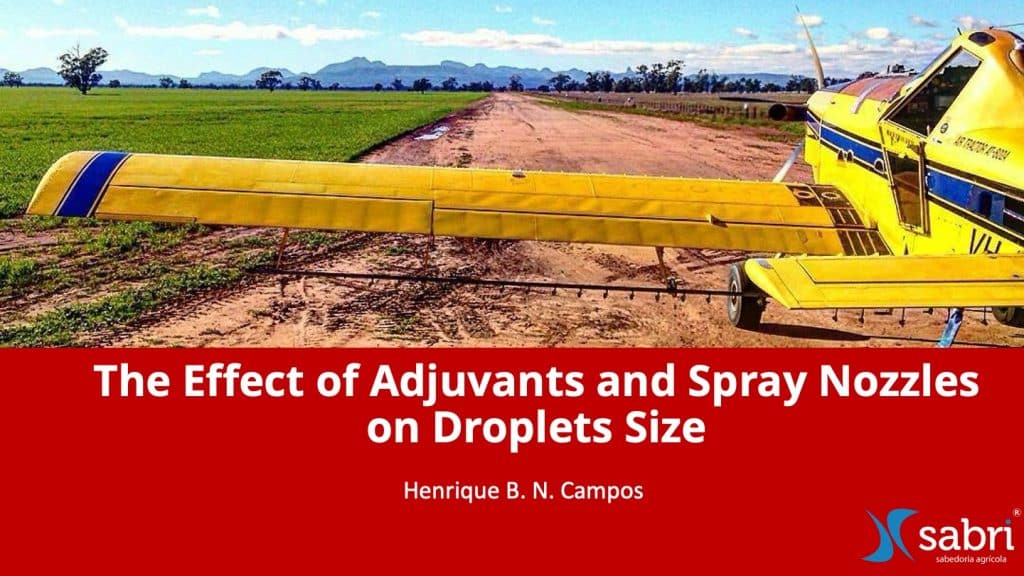
Author: Henrique Campos
Abstract: The adjuvant industry grows from the premise that its products can reduce the risk of pesticide spray drift. Polymer adjuvants have been used as anti-drift in general pesticide applications, however, few studies have been done to evaluate the effect of these products on the droplet size spectrum using rotary nozzles under aerial application conditions. The study was conducted in a high-speed wind tunnel.
Bio: Dr. Henrique Campos is an agronomist with a Masters and PhD in Pesticide Application Technology. He has researched adjuvants, spray nozzles and techniques for drift mitigation and has more than 10 years of experience with field and research trials as well as laboratory equipment. He is highly interested in all topics related to aerial application and sustainable agriculture.
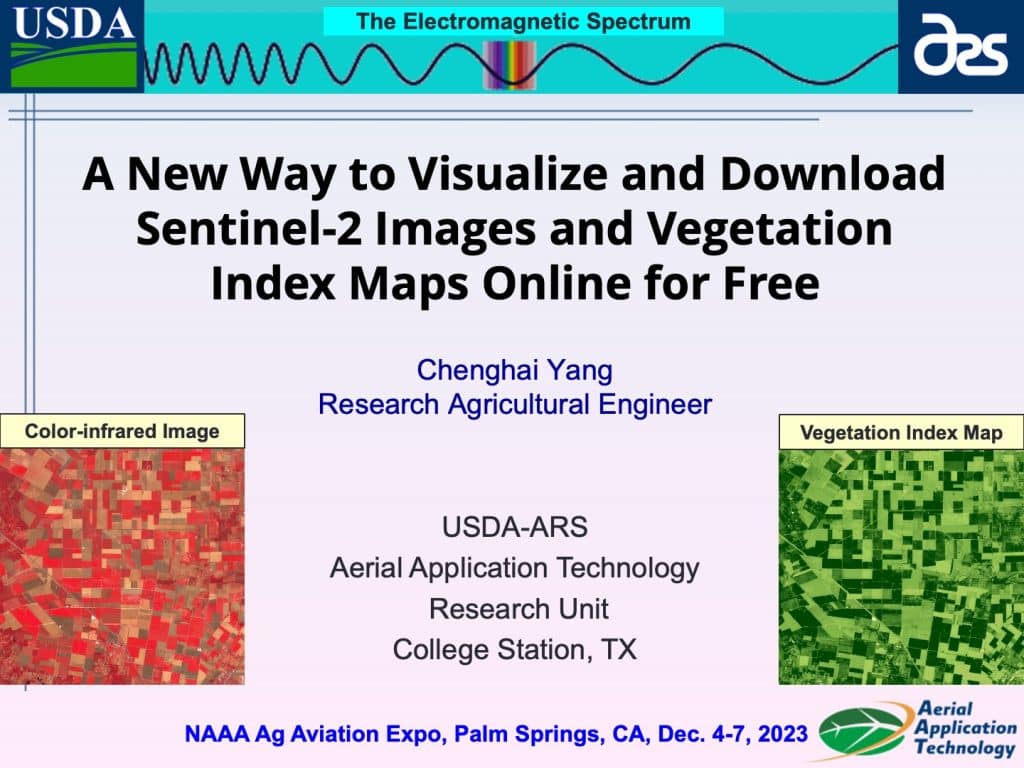
Authors: Chenghai Yang, PhD
Abstract: When discussing remote sensing images, you may have come across terms such as true color image, red-green-blue or RGB image, near-infrared or NIR image, color-infrared image, mid-infrared image, far-infrared image, thermal image, and more. These terms can be confusing for individuals who are not familiar with remote sensing. In this presentation, I will begin by providing a brief overview of different types of remote sensing images and clarifying the distinctions between these terms. Next, I will demonstrate a step-by-step procedure using the QGIS software to generate RGB and color-infrared images, the two most commonly used image types, from the individual band images extracted from a downloaded Sentinel-2 satellite scene. By following this procedure, you will learn how to create visually appealing composite images that showcase different aspects of the spectral features captured by the remote sensing sensor. Furthermore, I will illustrate the creation of a normalized difference vegetation index (NDVI) map, which is a valuable tool for assessing crop growth and health conditions. This information can be used to make an informed decision about site-specific application of production and protection materials. Through this presentation, you will gain the necessary skills to generate RGB and color-infrared images, as well as NDVI maps, using QGIS. These techniques will enhance your understanding of remote sensing images and enable you to incorporate remote sensing imagery into your business for various applications.
Bio: Dr. Chenghai Yang is a Research Agricultural Engineer with the USDA-ARS Aerial Application Technology Research Unit in College Station, TX. Dr. Yang’s research focuses on the development and application of remote sensing technologies for precision agriculture and pest management. His recent efforts include developing low-cost imaging systems for manned and unmanned aircraft and comparing their effectiveness with satellite imagery for assessing crop conditions for site-specific applications of crop production and protection materials. Dr. Yang has authored or co-authored over 170 peer-reviewed journal articles. He is a Fellow of the American Society of Agricultural and Biological Engineers and a member of several other national and international professional societies.
Authors: Steve Li
Abstract: Spray drones are being rapidly adopted in the United States as a popular alternative tool to apply pesticides on field crops, particularly fungicide over full size corn around tassel stage. However, research studies comparing the latest spray drone models to airplanes and ground sprayers are very rare. Therefore, field trials were conducted at multiple locations in 2022 and 2023 in AL and GA to compare spray drones to multiple airplanes and ground sprayers for deposition and canopy penetration. Aerial applications and ground sprayers used 2 and 15 GPA, respectively, to deliver same amount of spray dye per acre to corn plants. Results from 2022 field studies showed the Agras T30 delivered similar dye concentration and uniformity on corn ear leaves compared to airplane and ground sprayers. Flying higher with narrower swath produced highest uniformity. 2023 results indicated that the Agras T30, T40 and T20P generated similar or higher dye concentration on ear leaves and inside corn canopy compared with airplanes. Canopy density and leaf orientation may have played a role in dye concentration. Droplet size from spray drone applications using 300 um setting were generally bigger than airplane’s droplet size. Utilizing a drift reducing agent (DRA) and higher GPA increased deposition and spray dye concentration on some occasions but was not consistent across applications and study locations. Flying direction failed to affect deposition and spray dye concentration on ear leaves. More future field trials are still needed to evaluate spray deposition, canopy penetration and off-target movement as affected by application equipment, DRA, GPA, etc.
Bio: Dr. Steve Li is an associate professor and extension specialist in weed science – College of Agriculture, Auburn University. Dr. Li started his current position with Alabama Cooperative Extension System and Auburn University in February 2015 as extension specialist and assistant professor in the Department of Crop, Soil and Environmental Sciences. He covered numerous areas for extension including row crops, specialty crops, pasture and hayfield, non-crop area, home ground, etc. He is the team leader of the agronomic crop extension team. His research focuses on applied weed control in cotton-peanut rotation, application technology, pesticide drift and off-target movement, utilizing drones to apply pesticides and implementing precision application.
Author: Dan Martin
Abstract: Some areas of the United States have recently experienced the worst drought in over a century. Water resources are tightening and aquifers are not being recharged as quickly as needed for an ever-growing population. Drought hits agriculture particularly hard with reduced crop yields and increased food prices. Several states have implemented rain enhancement or snowpack augmentation programs to help increase water supplies. Conventional technology used to increase rainfall includes the burning of silver iodide or calcium chloride flares near cloud bases. The smoke from these flares provides a nucleus for water vapor in the clouds to attach to and grow in size until large enough to precipitate out as rain. Although not supported by scientific data, some individuals are concerned about the resulting possibility of silver in the water supply. Research conducted by USDA’s Aerial Application Technology Research Unit in College Station, Texas has shown that releasing charged water droplets into the updraft of convective clouds via agricultural aircraft generates just as much, if not more, extra rainfall as conventional methods. This presentation will discuss the rain enhancement research conducted to date and opportunities for the future.
Bio: Dr. Dan Martin is a Research Agricultural Engineer with the USDA-ARS Aerial Application Technology Research Unit and has over 30 years of training and experience in aerial spray application technologies for precision agriculture. He has authored/coauthored over 50 journal articles and has given over 100 technical presentations at regional, national, and international forums. He has held various leadership positions in professional societies and is recognized as a leading authority in manned and unmanned aerial application systems for precision agriculture and pest management.
Author: Senarath Dharmasena, Dan Martin and Kaitlyn Hughes (presenting)
Abstract: Agricultural aerial application industry in the United States provides important services for American farmers. According to a 2019 National Agricultural Aviation Association (NAAA) survey, the United States agricultural aviation industry treats about 127 million acres of cropland each year, which is approximately 28% of total commercially treated cropland. As an asset to American agriculture, it is important to determine how the state, regional, and national economies would be affected should such an industry become displaced. In this study, all U.S. states are evaluated based on the top five produced crops, measured by gross cash receipts. Data for 2019 provided by the NAAA and the USDA will be used to develop a counterfactual revenue reduction stochastic simulation model to estimate the value of the agricultural aerial application industry for each State’s economy, delineated by different crops and forestry products. The estimated simulation model will help understand the impact provided by U.S. agricultural aerial application industry on individual commodities and state economies. Preliminary analysis shows that the total revenue loss of not having agricultural aerial applications to United States. economy is about $37 billion (with probability of occurrence greater than 0.90). The results will aid decision making for applicators, regulators, and legislators.
Bio: Dr. Dharmasena is Associate Professor, Department of Agricultural Economics and Associate of the Agribusiness, Food and Consumer Economics Research Center (AFCERC) at Texas A&M University. His current research interests are in the areas of Consumer Economics and Applied Demand Analysis, Agribusiness and Food Market Analysis, Behavioral Economics, Health and Nutrition Economics, Economics of Food Security, Food Environments and Obesity, Causality Modeling, Probability Forecasting and Forecast Evaluation, and Market Integration and Price Discovery. He is an expert in applied econometric modeling, both structural and time-series.
Presented December 5, 2022 at the NAAA Ag Aviation Expo in Knoxville, TN – Aerial Application Technology Research Session
- Straight Stream Nozzle Models to Support Aerial Applications
- A novel, simple, easy to implement nozzle innovation for significant reduction in driftable fines during aerial applications
- Using freely available satellite imagery and software for creating crop growth and prescription maps
- Newer Pattern Testing Collection Equipment
- Card Based Spray Pattern Testing System Designed for Aerial Applicators to Use
- Comparison of herbicide spray drift from ground and aerial application
- Effect of Application Rate on Fungicide Efficacy from an Aerial Application for Control of Sheath Blight in Rice
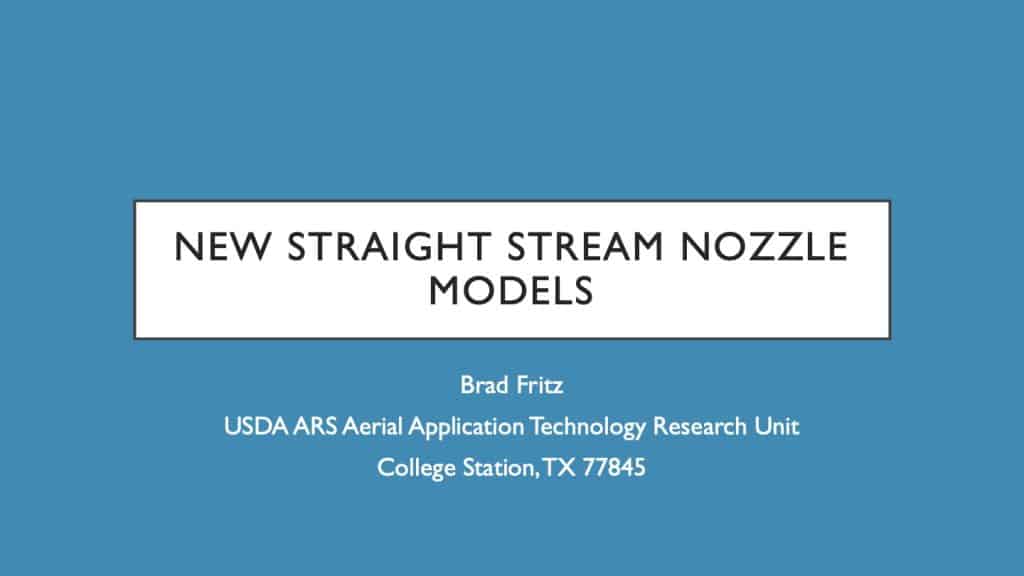
Author: Brad Fritz, PhD
Abstract: Maintaining operational efficiency while mitigating spray drift potential can be challenging, particularly with modern aircraft that are capable of higher airspeeds. One of the easiest and most effective tools for reducing off-target movement is increasing droplet size, which minimizes the fraction of spray volume containing smaller, drift prone droplets. Proper nozzle selection and use is the first, and most significant step towards improving overall spray characteristics. Models that guide nozzle selection and use are available for the most used widely used aerial application nozzles. However, straight stream nozzles designed for ground boom banded spray applications were recently tested and used by aerial applicators and similar models were requested. To support the increasing interest and use of these nozzles, and to provide the spray performance data needed to adhere with agrochemical product labels, new droplet size models were developed. Two straight stream nozzle types were tested in a laboratory high speed wind tunnel using laser diffraction to measure droplet size. Models were developed that cover all orifice sizes, spray pressures from 30 to 90 psi, and airspeeds from 120 to 180 mph. Overall performance and droplet size trends across the entire operational space are presented and discussed. These models allow users to identify nozzle sizes and spray pressures that will deliver specified droplet sizes and classifications at any desired operational airspeed.
Bio: Dr. Brad Fritz is an agricultural engineer and serves as the Research Leader of the USDA ARS Aerial Application Technology group in College Station, Texas. His areas of research include spray drift measurement and mitigation, spray atomization, and optimization of application technologies and methods to enhance on target deposition while mitigating off target impact. He is currently an active member of a number of professional organizations including the American Society of Agricultural and Biological Engineers, ASTM E35, the American Mosquito Control Association, and the National Agricultural Aviation Association.
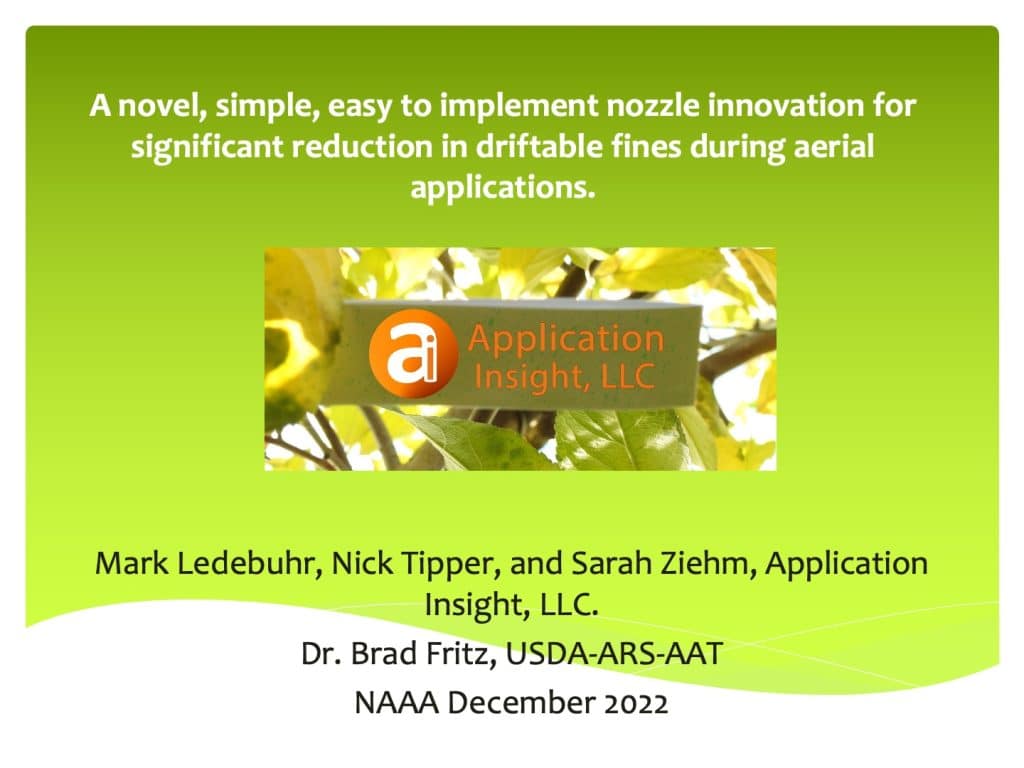
Authors: Mark Ledebuhr, Nicholas Tipper, Sarah Ziehm (Application Insight, LLC) and Brad Fritz, PhD (USDA-ARS AATRU)
Abstract: Application Insight spent many months in design and nearly a month in the USDA-ARS-AAT wind tunnel innovating to improve the interactions between high-speed turbulent air and the spray jet in aerial applications. The goal of this work was reduction of driftable fines while maintaining a desirable droplet spectrum in real-world aerial application conditions. Focus was on a solution that is easily implemented and fits the cultural and operational needs of applicators.The successes, failures, and next steps of this project will be discussed.
Bio: Mark Ledebuhr is the managing partner of Application Insight, LLC. Application Insight focuses on developing and optimizing spray application systems, in specialty and commodity crops, developing and improving methods for evaluation of spray application. Mr. Ledebuhr works collaboratively with hardware and chemical manufacturers, universities, state and federal government agencies, and private growers worldwide. He is a member of American Society of Agricultural and Biological Engineers (ASABE) Application Systems Committee PM23/6, American Society of Testing and Materials (ASTM) Committees E35 and E29, American Society of Pesticide Safety Educators (AAPSE), National Association of Independent Crop Consultants.(NAICC) and a member of the US delegation to International Standards Organization (ISO) Subcommittee TC23/SC6 (Application Systems). Current active research projects include: optimization of aerial application nozzles and high-pressure delivery systems, improvement of spray educational tools, development of high-resolution, high speed swath analysis methodologies, adaptation of ultra-low volume (ULV) technologies for vector control in drones, Solid Set Canopy Deposition Systems (SSCDS) for orchard spraying, and novel methods of drift detection technology. Ledebuhr is the co-author of the recently released book Airblast 101, recognized as the definitive text on the use and optimization of airblast and air-assisted spraying technologies.
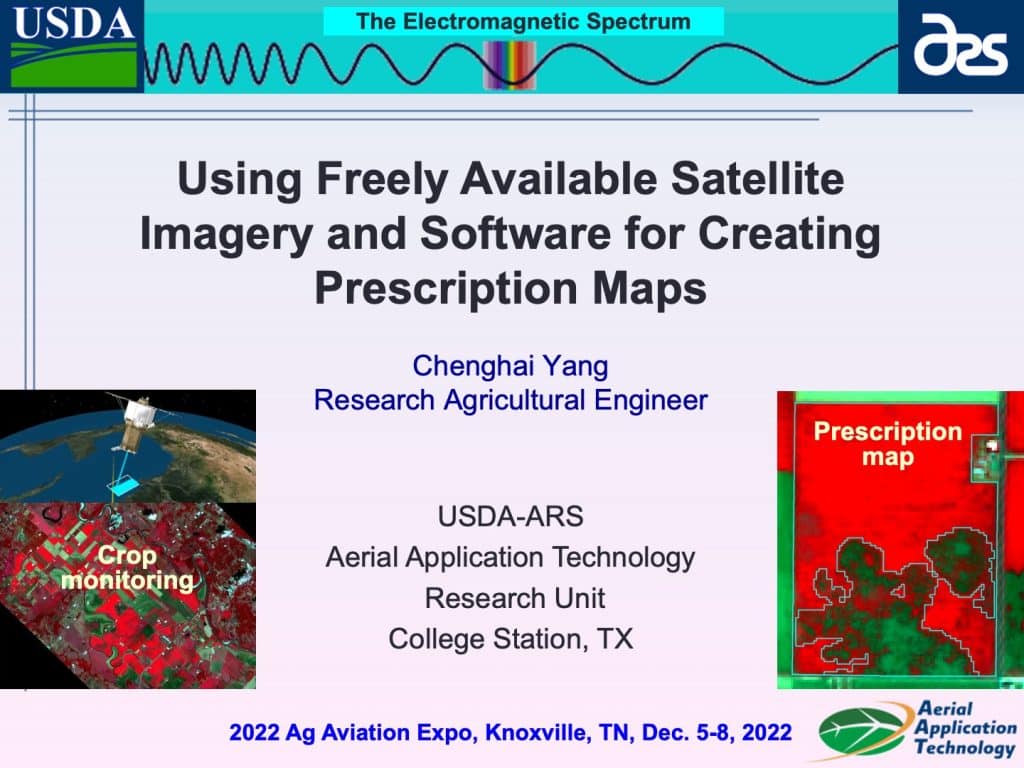
Author: Chenghai Yang, PhD
Abstract: The rapid increase in remote sensing data sources today presents both opportunities and challenges to remote sensing practitioners and end users. Remote sensing data are generally obtained using three major types of platforms: satellites, manned aircraft, and unmanned aircraft systems (UAS). UAS will be appropriate if imagery is needed for a small area or at very high spatial resolution. Manned aircraft or satellites will be more effective for imaging at farm or regional level. Although image users are aware of the availability of different image data sources, many of them are not clear what type of imagery to select, how to obtain it, and how to convert it to useful map products. This presentation will demonstrate practical procedures on how to use Sentinel-2 satellite imagery and the QGIS software, both of which are freely available to end users, to create useable vegetation maps for crop growth assessment and prescription maps for site-specific chemical application. Specifically, step-by-step procedures will be presented on how to download Sentinel-2 images and the QGIS software and how to view and process the images using QGIS. As an example, a Sentinel-2 image from a cropping area will be used to create both a normal color and a color-infrared image composite for image visualization, and a normalized difference vegetation index (NDVI) map for crop growth and health assessment. Furthermore, the NDVI image for a field will be classified into multiple zones to differentiate within-field plant growth variability that can be used for site-specific chemical application.
Bio: Dr. Chenghai Yang is a Research Agricultural Engineer with the USDA-ARS Aerial Application Technology Research Unit in College Station, TX. Dr. Yang’s research focuses on the development and application of remote sensing technologies for precision agriculture and pest management. His recent efforts have focused on developing low-cost imaging systems and image processing techniques and evaluating these systems with satellite imagery for assessing crop conditions for site-specific chemical applications. Dr. Yang has authored or co-authored over 160 peer-reviewed journal articles and serves on several national and international professional societies.
Author: Randy Price, PhD
Abstract: A newer GoPro based pattern testing system was developed to analyze pattern test strings from aerial aircraft using standard parts and components from a local hardware store. The system uses a GoPro camera, green laser, and rhodamine filter to analyze the test strings, a cordless drill and measuring wheel to move the string through the device, and two 90-degree drill driver attachments and a paint roller to collect the strings. Advantages of the system are that it can be used over a larger set of environmental conditions, can collect test strings in 10 to 35 seconds, and requires fewer people to operate on the flight-line.
Bio: Dr. Price is an Associate Professor at the LSU AgCenter, Baton Rouge, Louisiana. He continually works on new equipment and methods to help the agricultural spray plane industry and is a certified Operation S.A.F.E. analyst.
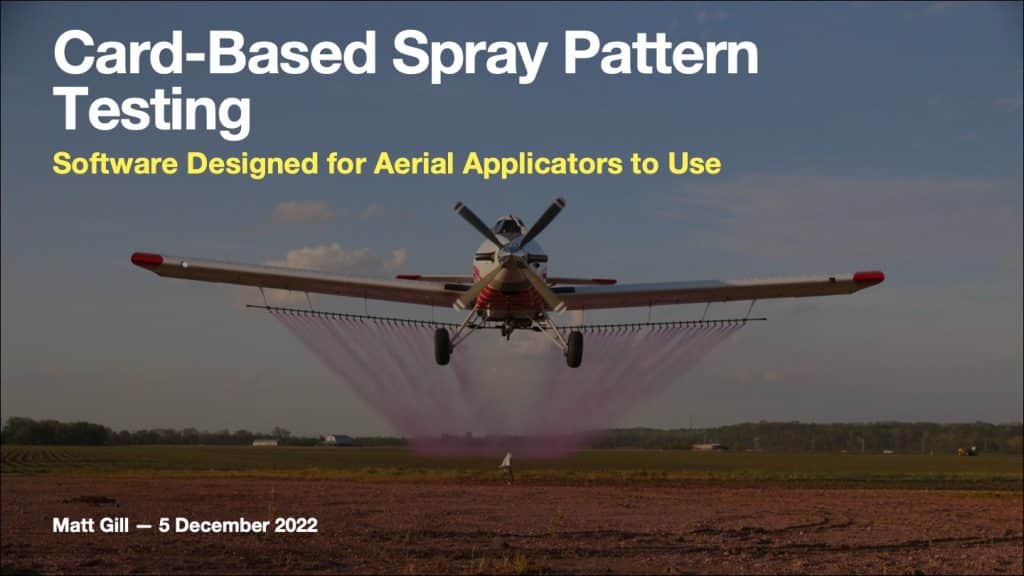
Author: Matt Gill
Abstract: The importance of periodically testing your spray pattern is well established and it is now a component of NAAA’s new Certified-Professional Aerial Applicator Safety Steward (C-PAASS) program. However, many applicators who wish to attend an Operation S.A.F.E. clinic are unable to do so. There may be a timing conflict with the clinic, or there may simply be no clinics regularly offered nearby. For folks in this situation, a new software tool and simple sampling protocol are available to help you perform your own spray pattern testing. The materials and methods used are almost identical to that of a standard Operation S.A.F.E. clinic, except that tightly spaced sampling cards are used in lieu of string and only a single ground helper is required. After processing the cards, the software tool provides swath-width and uniformity information as well as droplet spectrum data. With your data in hand, if you choose to remotely consult with an Operation S.A.F.E. Analyst, they may also record your official participation in Operation S.A.F.E.
Bio: Matt Gill is NAAA’s manager of education, safety and policy. He formerly was an Extension Specialist at the University of Illinois and has served as an Operation S.A.F.E. Analyst since 2011.
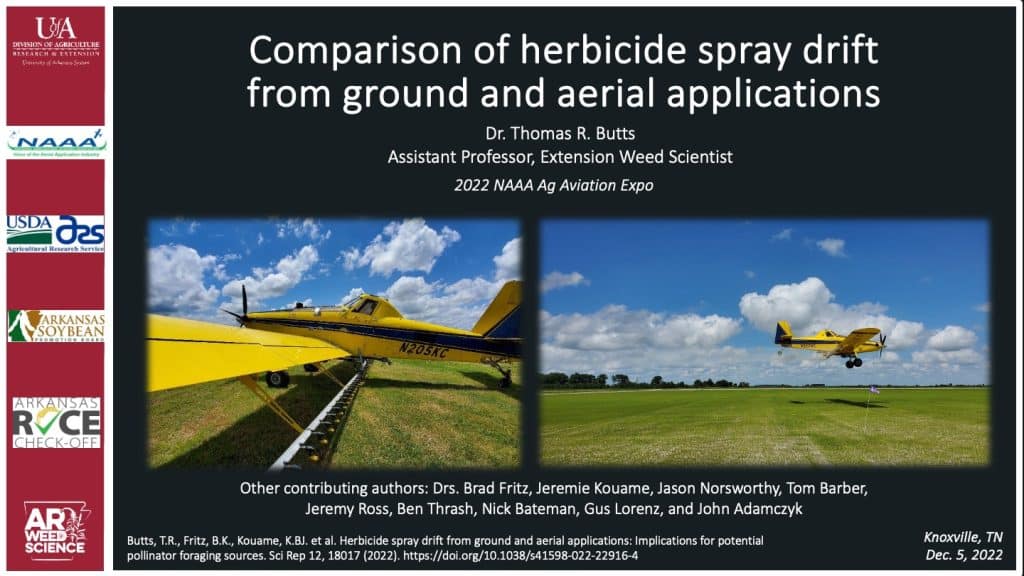
Author: Tommy Butts, PhD
Bio: Dr. Tommy Butts is an Assistant Professor and Extension Weed Scientist at the University of Arkansas. His research and Extension efforts focus on identifying novel weed management strategies for Arkansas rice and soybean cropping systems through diversified approaches. These strategies include the utilization of cultural, mechanical, and chemical practices used in a holistic system for weed management. The overall goal is to provide sound, effective, and applicable weed management practices to Arkansas and Mid-South rice and soybean growers battling complex weed problems in their fields. Additionally, a primary focus is placed on identifying the impact of precision agriculture and application technologies on weed management as these tools continue to grow in popularity. Further emphasis is placed on helping to increase herbicide application knowledge, safety, and effectiveness, both from ground-based and aerial applications.
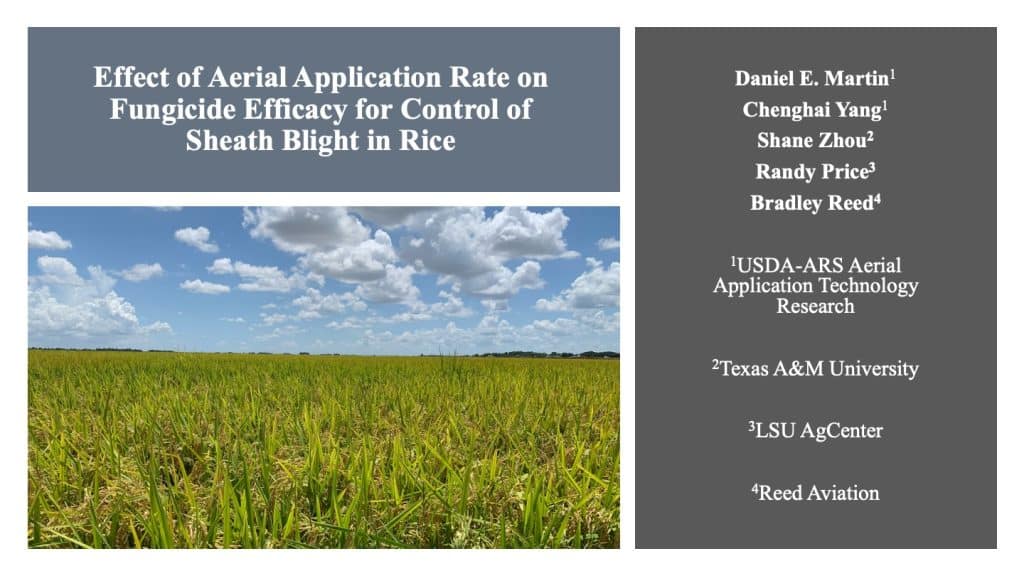
Author: Daniel E. Martin, PhD
Abstract: Ever wondered if putting out a product at 2 GPA could work just as well as an application at 5 GPA? Applications at lower volumes not only save time and money, but also can make aerial applications more timely so that pests are controlled before they can do additional damage. The objective of this study was to determine if lower application rates of fungicide for control of sheath blight in rice can be just as effective as higher application rates. Aerial applications were made at 2 and 6 GPA. Efficacy of disease control was evaluated by plant pathologists at the Texas A&M AgriLife Research Station in Beaumont, Texas. In addition, aerial images were taken of the field, before and after treatment, to assess control. Results of the 2nd year of this study will be presented and discussed.
Bio: Dr. Martin is a Research Agricultural Engineer with the USDA-ARS Aerial Application Technology Research Unit and has over 30 years of training and experience in aerial spray application technologies for precision agriculture. He has authored/coauthored over 50 journal articles and has given over 100 technical presentations at regional, national, and international forums. He has held various leadership positions in professional societies and is recognized as a leading authority in manned and unmanned aerial application systems for precision agriculture and pest management.
Presented December 6, 2021 at the NAAA Ag Aviation Expo in Savannah, GA – Aerial Application Technology Research Session
- Evaluation of Light Sport Aircraft as an Aerial Imaging Platform
- Simulating Reality — Using CFD to Simulate Spray Nozzles
- Effects of Pulse Width Modulation Nozzles on Droplet Size and Flow Rate
- Value of the Agricultural Aerial Application Industry in the United States
- Development of Analysis Equipment for Pattern Testing Agricultural Aircraft
- Effect of Application Rate on Fungicide Efficacy from an Aerial Application for Control of Sheath Blight in Rice
- Developing a High Pressure, Modular Chemical Delivery System for Aerial Application Platforms
Authors: Chenghai Yang, PhD, Jonathan T. Scott
Abstract: Remote sensing data are generally obtained using three major types of platforms: satellites, manned aircraft, and unmanned aircraft systems (UAS). Compared with satellites and UAS, manned aircraft are more versatile to capture images with desired coverage and resolution. Light sport aircraft (LSA) are a fairly new certification of small, lightweight aircraft defined by a maximum takeoff weight of 1,300 pounds (600 kilos). They can be markedly less expensive than larger manned aircraft. LSA therefore have the potential to be a flexible, versatile and economical platform for aerial imaging. In collaboration with the Circular Economy Research Center (CERC) at Ecole des Ponts Paris Tech, we evaluated the feasibility, performance, and economics of using LSA as aerial imaging platforms. Our flight tests included an all-metal fixed-wing aircraft (Colt-100), a composite-based, fixed-wing motor-glider (Pipistrel Sinus) and a composite-based gyroplane (Magni M24). Each aircraft was equipped with a two-camera system and flew an identical 30,000-acre cropping area in June 2021. Preliminary results showed that all three LSA feasibly carried the imaging system, successfully flew over the predetermined flight lines, and efficiently collected the required images. Economic and material analysis results are currently being collected and reviewed to determine the strengths and weaknesses associated with using LSA in imaging work. It is important to note that the FAA is expected to authorize commercial use of LSA sometime in 2023, so it is conceivable that LSA can be integrated into the aerial application industry as an alternative, affordable, and less-polluting, aerial-imaging platform.
Bio: Dr. Chenghai Yang is a Research Agricultural Engineer with the USDA-ARS Aerial Application Technology Research Unit in College Station, TX. Dr. Yang’s research focuses on the development and application of remote sensing technologies for precision agriculture and pest management. His recent efforts have focused on developing low-cost imaging systems and image processing techniques for aerial applicators and evaluating these systems for assessing crop conditions for site-specific chemical applications. Dr. Yang has authored or co-authored 160 peer-reviewed journal articles and serves on a number of national and international professional societies.
Author: Sam Marx
Abstract: There are a wide range of nozzle types, nozzle flow rates, and droplets produced by those nozzles. Many nozzles are made using empirical evidence and testing physical models to determine how that nozzle preforms. By using computational fluid dynamics (CFD), nozzle geometry can be modeled, and the atomization process can be simulated numerically. Using CFD to simulate nozzles may allow for faster development of future nozzles and/or attempting nozzle geometries that are not common manufacturing practice. This presentation will introduce the audience to how simulation might be beneficial for nozzle development as well as some examples of current nozzle geometries being simulated.
Bio: Sam Marx is currently a Research Technologist for the Biological Systems Engineering Department at the University of Nebraska-Lincoln. He is simultaneously pursuing his PhD in Agricultural and Biological Systems Engineering at UNL. His current research includes aerial nozzle development using computational fluid dynamic modeling as well as other ground based and UAV precision application technologies. Sam has a history in the agricultural engineering industry working on development, testing and production of agricultural application systems, including aerial application equipment. Sam is an active member of ASABE where he is Chair of the MS-23/6/2 Aerial Application Standards and Safety Committee and former Vice Chair of the MS-23/6/5 Anhydrous Ammonia Application Standards and Safety Committee.
Author: Brad Fritz, PhD
Abstract: The ability to control spray application rate during flight is becoming more critical as the need to address the demand for precision applications increases. While flow control systems have been commercially available and in use for some time, most alter flow through changes in spray pressure, which has the additional effect of altering droplet size. The use of pulse width modulation (PWM) valves offer the benefit of modifying pressure while maintaining droplet size from the nozzle. While some limited testing of these systems has been completed, there is a need for more rigorous testing and development of PWM specific droplet size models for the nozzles integrated into these systems. This provides more accurate data that can be integrated into the decision support software of current systems. A commercially available PWM system was evaluated for droplet size and flowrates for several commonly used aerial nozzles covering a range of airspeeds and pressures. Further, droplet sizing models were developed that incorporated PWM duty cycle as a parameter in addition to airspeed, pressure, orifice size and orientation angle.
Bio: Dr. Brad Fritz is an agricultural engineer and serves as the Research Leader of the USDA ARS Aerial Application Technology Unit in College Station, Texas. His areas of research include spray drift measurement and methods of mitigation, understanding the role spray nozzles and formulations play in the droplet size being applied and optimizing aerial application technologies and methods to enhance on target deposition and reduce off-target impacts. He is an active member of a number of professional organizations including the American Society of Agricultural and Biological Engineers, the American Society of Testing and Materials, the American Mosquito Control Association, and the National Agricultural Aviation Association.
Authors: Senarath Dharmasena, PhD, Daniel E. Martin, PhD
Abstract: Aerial application is very critical component of high-yielding and highly efficient current-day U.S. agriculture. This industry is important to aerial applicators, farmers and ranchers, and consumers of the food, fiber, and forestry products. Furthermore, given the current global health crisis related to COVID-19 pandemic, the importance of this industry to keep a continuous supply of agricultural products to the U.S. economy is further highlighted. Dharmasena and Martin (2020) estimated the value of the agricultural aerial application industry based on the revenue forgone by the U.S. farmers. However, this study only considered selected crops (such as corn for grain, wheat, cotton, soybeans, rice) grown in the United States and the state of Texas to estimate the value of the agricultural aerial application industry only considering the lost revenue at the farm-gate level. Given the complexity of the agricultural value channel with multiple players such as input suppliers, farmers, processors (includes transportation, storage, processing), wholesales, and retailers, the revenue losses estimated by Dharmasena and Martin (2020) can be expanded to include all participants in the agricultural value channel. In addition to that, the crops and forestry products grown vary across states of the United States and due to that the revenue forgone will also differ based on the agricultural practice. In this study, data from National Agricultural Aviation Association and the USDA Economic Research Service is used to develop an economic model using cutting-edge econometric tools to estimate the value of the aerial application industry to the United States economy delineated by different crops/forestry products and states, and different stages of the agricultural value channel.
Bio: Dr. Dharmasena is Associate Professor, Department of Agricultural Economics, Texas A&M University. Economics and Applied Demand Analysis, Agribusiness and Food Market Analysis, Behavioral Economics, Health and Nutrition Economics, Economics of Food Security, Food Environments and Obesity, Causality Modeling, Probability Forecasting and Forecast Evaluation, and Market Integration and Price Discovery. He is an expert in applied econometric modeling, both structural and time-series. He is member of several national and international professional associations and is Fellow of Critical Thinking Academy of Texas A&M University.
Authors: Randy Price, PhD, Daniel E. Martin, PhD, and Kim Brown
Abstract: Pattern testing of agricultural aircraft is an important feature to maintain consistent spray patterns and low coefficients of variation (C.V.). Still, most pattern testing equipment requires multiple people to operate and stores the pattern test strings on reels, which can greatly limit the number and the amount of test you can perform. We have been working on a system to increase the number of tests that can be performed per flight and even allows full-field testing. This system uses a GoPro camera and green laser system mounted at the collection-end of the flight-line to analyze the strings as it is “pulled-in” from the flight-line for reflectance patterns. This system was successfully used during the 2020 season and greatly reduced the number of people needed to operate the flight-line and the work involved in collecting strings allowing for one person to perform tests on many occasions. It was also successfully used to perform multi-pass, large field scale tests, where swath predictions can be checked and verified to help instill confidence in swath width recommendations to spray plane pilots and operators. This presentation will talk about this system, testing methods, and results from these tests.
Bio: Dr. Randy Price is an Associate Professor at the LSU AgCenter, Baton Rouge, Louisiana. He continually works on new equipment and methods to help the agricultural spray plane industry and is a certified Operation S.A.F.E. analyst.
Authors: Daniel E. Martin, PhD, Chenghai Yang, Xin-Gen Zhou, Randy Price, Bradley Reed
Abstract: Ever wondered if putting out a product at 2 GPA could work just as well as an application at 5 GPA? Applications at lower volumes not only save time and money, but also can make aerial applications more timely so that pests are controlled before they can do additional damage. The objective of this study was to determine if lower application rates of fungicide for control of sheath blight in rice can be just as effective as higher application rates. Aerial applications were made at 2 and 6 GPA. Efficacy of disease control was evaluated by plant pathologists at the Texas A&M AgriLife Research Station in Beaumont, Texas. In addition, aerial images were taken of the field, before and after treatment, to assess control. Results of the study will be presented and discussed.
Bio: Dr. Martin is a Research Agricultural Engineer with the USDA-ARS Aerial Application Technology Research Unit and has over 30 years of training and experience in aerial spray application technologies for precision agriculture. He has authored/coauthored over 50 journal articles and has given over 100 technical presentations at regional, national, and international forums. He has held various leadership positions in professional societies and is recognized as a leading authority in manned and unmanned aerial application systems for precision agriculture and pest management.
Author: Mark Ledebuhr
Presented December 7, 2020 at the NAAA Ag Aviation Expo in Savannah, GA – Aerial Application Technology Research Session
- Variation in Your Spray Swath
- Identification of Cotton Fields Using Aerial and Satellite Imagery
- Evaluation of Aerial Application Nozzles
- Development of Analysis Equipment for Pattern Testing Agricultural Aircraft
- How Much is the Aerial Application Industry in the United States Worth?
- Aerial Application Methods for Control of Winter Weeds
Author: Sam Marx
Abstract: A review of what droplet size is, how droplets of different sizes move and how that movement can impact the uniformity of your swath. Swath uniformity is tied to a value listed in string pattern testing results, coefficient of variation or CV. We will discuss what CV is and how that number can be impacted by adjusting operating parameters (e.g. spray nozzle size, spray pressure, etc.) to provide a more uniform spray swath.
Bio: Sam Marx is currently a Research Technologist for the Biological Systems Engineering Department at the University of Nebraska-Lincoln. He is simultaneously pursuing his PhD in Agricultural and Biological Systems Engineering at UNL. His current research includes aerial nozzle development using computational fluid dynamic modeling as well as other ground based and UAV precision application technologies. Sam has a history in the agricultural engineering industry working on development, testing and production of agricultural application systems, including aerial application equipment. Sam is an active member of ASABE where he is Chair of the MS-23/6/2 Aerial Application Standards and Safety Committee and Vice Chair of the MS-23/6/5 Anhydrous Ammonia Application Standards and Safety Committee.
Author: Chenghai Yang, PhD
Abstract: Remote sensing has long been used for crop identification, but limited work has been reported on its use for identification of cotton fields when cotton plants are small. Early identification of cotton fields is important for advancing the boll weevil eradication program in Texas. Our previous work has demonstrated that aerial imagery with high spatial resolution (<1 m) was effective for this purpose, but large numbers of aerial images are needed to cover large geographic regions. As no-cost Sentinel-2 satellite imagery that has large area coverage with relatively high resolution (10 m) has become available in recent years, we evaluated this type of imagery for differentiating cotton fields from other crops before cotton plants start to bloom. Multiple cloud-free Sentinel-2 scenes acquired during the growing seasons in 2019 and 2020 over a 6 mile by 6 mile cropping area near College Station, TX, were selected to identify cotton fields. The images were classified into different crops and cover types using multiple classification techniques. Results showed that Sentinel-2 imagery in conjunction with appropriate classification techniques was feasible for distinguishing cotton from other crops. The methodologies presented in this study provide boll weevil eradication program managers with a practical tool to identify cotton fields over large geographic areas at relatively early growth stages.
Bio: Dr. Yang is a Research Agricultural Engineer with the USDA-ARS Aerial Application Technology Research Unit in College Station, TX. His research focuses on the development and application of remote sensing technologies for precision agriculture and pest management. Recent efforts have focused on developing low-cost imaging systems and image processing techniques for aerial applicators and evaluating these systems for assessing crop conditions for site-specific chemical applications. Dr. Yang has authored or co-authored 160 peer-reviewed journal articles and serves on a number of national and international professional societies.
Author: Brad Fritz, PhD
Abstract: The USDA ARS wind tunnel facilities, used to evaluate aerial application nozzles, recently underwent a significant upgrade, adding a spray scrubber, instrumentation to monitor spray system and airstream conditions, and additional automation to existing components. With these improvements comes a need to compare results from the new facilities to data from the older tunnel configuration. Initial assessments measure and compare a standard set of reference nozzles that are designed to reveal any potential errors or bias in data from different facilities or system configurations. Then, to provide comparisons to data contained in the existing USDA ARS Spray Atomization models, a selection of 25 new nozzles for several different nozzle types and orifice sizes were evaluated and the results compared. It is expected that some level or variation in flowrate and droplet size exists between identical, factory new nozzles, however the current models do not account for this. By analyzing the groups of 25 identical nozzles, an expected range in flowrate and droplet size can be determined allowing for more appropriate comparisons to the data from the nozzle models. A number of “worn” nozzles, sourced from applicators were also evaluated for flowrate and droplet size and compared to their factory new counterparts. The results are intended to demonstrate that the new facilities provide comparable data to historical data as well as provide guidance on what potential variation may exist amongst worn new and worn nozzles of the same type.
Bio: Dr. Fritz is an agricultural engineer and serves as the Research Leader of the USDA ARS Aerial Application Technology Unit in College Station, Texas. His areas of research include spray drift measurement and methods of mitigation, understanding the role spray nozzles and formulations play in the droplet size being applied and optimizing aerial application technologies and methods to enhance on target deposition and reduce off-target impacts. He is an active member of a number of professional organizations including the American Society of Agricultural and Biological Engineers, the American Society of Testing and Materials, the American Mosquito Control Association, and the National Agricultural Aviation Association.
Author: Randy Price, PhD
Abstract: Pattern testing of agricultural aircraft is an important feature to maintain consistent spray patterns and low coefficients of variation (C.V.). Still, most pattern testing equipment requires multiple people to operate and stores the pattern test strings on reels, which can greatly limit the number and the amount of test you can perform. We have been working on a system to increase the number of tests that can be performed per flight and even allows full-field testing. This system uses a GoPro camera and green laser system mounted at the collection-end of the flight-line to analyze the strings as it is “pulled-in” from the flight-line for reflectance patterns. This system was successfully used during the 2020 season and greatly reduced the number of people needed to operate the flight-line and the work involved in collecting strings allowing for one person to perform tests on many occasions. It was also successfully used to perform multi-pass, large field scale tests, where swath predictions can be checked and verified to help instill confidence in swath width recommendations to spray plane pilots and operators. This presentation will talk about this system, testing methods, and results from these tests.
Bio: Dr. Price is an Associate Professor at the LSU AgCenter, Baton Rouge, Louisiana. He continually works on new equipment and methods to help the agricultural spray plane industry and is a certified Operation S.A.F.E. analyst.
Author: Senarath Dharmasena, PhD
Abstract: Agricultural aerial applications have been used in the United States for nearly one hundred years for producing a safe, affordable and abundant supply of food, fiber and biofuel, in addition to protecting forestry and controlling health-threatening pests. Aerial application is very critical component of high-yielding and highly efficient current-day U.S. agriculture. Compared to ground application equipment, aerial application is up to three times as efficient and can treat a variety of fields. According to a 2019 NAAA survey, the agricultural aviation industry in the United States treats about 127 million acres of cropland each year, which is approximately 28% of the total commercially treated U.S. cropland.
Aerial application industry in the United States is important to many participants. Most people know that the industry has tremendous value, but having an objective measure of the industry’s far-reaching impact on the U.S. economy would be useful not only to the industry but also to legislators, producers and consumers. The importance of this industry to keep the continuous food, fiber and forestry products supply to the U.S. economy is further highlighted during the current global health crisis related to COVID-19 pandemic. Due to this health crisis, the agricultural supply chains were disrupted as never seen before and it is still important that the U.S. agricultural producers continue to produce healthy, nutritious and affordable food to keep the population fed with the help of agricultural aerial applicators.
The big question is what would happen if aerial application were no longer operative. What would be the cost to the U.S. economy? Therefore, given the importance of this industry to the United States economy, this study estimates the economic value of the U.S. aerial application industry. As such, we expect that this study will aid in prudent decision-making for aerial applicators, regulators, and legislators. This study estimates the economic value based on the revenue forgone by U.S. farmers of not having aerial applications to treat their crops, hence loss of cultivated cropland followed by the loss of yield and farm revenue.
Crop acreage and production data are gathered from United States Department of Agriculture—National Agricultural Statistical Service (USDA-NASS) crop production 2018 summaries (published in February 2019). Once this simulation model is run for all crops considered in this study (cotton, corn for grain, wheat, soybean and rice), the total revenue loss of not having agricultural aerial applications to the Texas and the U.S. economy was about $0.7 and $23 billion, respectively, in 2018. This is substantial provided the economic activity that these raw crops would have created.
Bio: Dr. Dharmasena is Assistant Professor, Department of Agricultural Economics and Associate of the Agribusiness, Food and Consumer Economics Research Center (AFCERC) at Texas A&M University. His current research interests are in the areas of Consumer Economics and Applied Demand Analysis, Agribusiness and Food Market Analysis, Behavioral Economics, Health and Nutrition Economics, Economics of Food Security, Food Environments and Obesity, Causality Modeling, Probability Forecasting and Forecast Evaluation, and Market Integration and Price Discovery. He is an expert in applied econometric modeling, both structural and time-series.
Author: Daniel E. Martin, PhD
Abstract: Prolific growth of weeds is common on Texas farms during early winter and spring when farmers begin chiseling and disking operations for spring planting. Objectives of this research were to evaluate aerial application methodologies for the control of weed species in farmlands left fallow until spring. This is likely to facilitate low or no-till production agriculture through efficacious management of winter weeds. Glyphosate was aerially applied using a fixed wing aircraft and conventional hydraulic and electrostatic nozzles during year one. In year two, rotary atomizers were added as an additional treatment. Control plots were maintained during both years. The spray application rates for the conventional and rotary nozzles were 3 GPA while that for the electrostatic nozzle was 1 GPA. Aerial and ground-based spectral reflectance data quantified weed injury. The efficacy of each of the aerial application technologies will be discussed. The results from the study will help provide guidance to aerial applicators seeking to make efficacious herbicide applications for control of winter weeds.
Bio: Dr. Martin is a Research Agricultural Engineer with the USDA-ARS Aerial Application Technology Research Unit in College Station, TX. Prior to his tenure with ARS, he directed the aerial application extension program in Louisiana for 10 years, working one-on-one with aerial applicators as an Operation SAFE Analyst and Extension Educator. Currently, he conducts variable rate, UAS and electrostatic aerial application research. He is an active member of several professional societies, serves on several technical committees and has authored numerous refereed publications.

